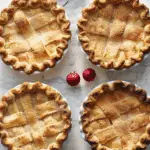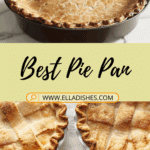Best Pie Pan: Choosing the Right One for Perfect Pies
Discover the pros and cons of glass, ceramic, metal, and disposable pie pans with side-by-side baking tests. Learn which pie pan gives you the crispiest crust and why material matters for the perfect pie.
- Prep Time: 15 minutes
- Cook Time: 25–30 minutes
- Total Time: 1 hour 15 minutes
- Yield: 1 pie crust (about 8 slices)
- Category: Baking, How-To, Pie Crust Techniques
- Method: Blind Baking, Oven Baking
- Cuisine: American
- Diet: Vegetarian
Ingredients
For 1 single 9-inch crust:
1 ¼ cups all-purpose flour (150g)
½ cup (1 stick) unsalted butter, cold and cubed (113g)
1 tablespoon granulated sugar
½ teaspoon salt
3–5 tablespoons ice water (as needed)
For a double crust (top + bottom):
2 ½ cups all-purpose flour (300g)
1 cup (2 sticks) unsalted butter, cold and cubed (226g)
2 tablespoons granulated sugar
1 teaspoon salt
6–10 tablespoons ice water
Instructions
Prepare the pie dough using a standard pie crust recipe and chill well.
Roll out the crust and place it into each type of pie pan: glass, ceramic, metal, and disposable.
Blind bake all crusts at the same temperature for the same amount of time.
Remove from the oven and observe browning, texture, and structure.
Compare results, noting which pans produced the most even browning and best crust stability.
Notes
A glass pan is ideal for beginners because you can monitor browning.
Ceramic pans excel in presentation and are perfect for deep-dish fruit pies.
Metal pans heat quickly and help achieve firmer, crispier crusts—especially dark metal.
Disposable pans work surprisingly well and are perfect for transporting or gifting pies.
Always check whether glass pans are freezer-to-oven safe before baking a frozen pie.

